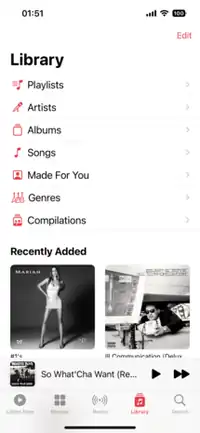Music (Apple)
Music (also known as Apple Music, the Apple Music app, and the Music app[1])[n 1] is a media player application developed for the iOS, iPadOS, tvOS, watchOS, macOS, Android, and Windows 11 operating systems by Apple Inc.[2] It can play music files stored locally on devices, as well as stream from the iTunes Store and Apple Music.
 Library tab in the Music app for iOS 16 | |
| Developer(s) | Apple Inc. |
|---|---|
| Initial release | iOS:
|
| Stable release | macOS: 1.3.4.56
/ March 27, 2023 |
| Operating system | iOS (all versions) watchOS (all versions) tvOS (all versions) iPadOS (all versions) macOS Catalina and later Android 5.0 and later Windows 11 and later |
| Predecessor | iPod (iOS) iTunes (macOS) |
| License | Freeware |
| Part of a series on |
| macOS |
|---|
On iPhones running iOS 4 or older software, it was named "iPod".[3] It was included in the initial releases of tvOS, watchOS, and iPadOS. It was released with macOS Catalina on October 7, 2019, as one of three applications created to replace iTunes.[4] The Music app is differentiated from iTunes by its concentration on streaming media and lesser focus on the iTunes Store, where content may be purchased outright.
iOS, tvOS, and watchOS versions
The Music app on iOS was initially released in iPhone OS 1 as the iPod app, and was renamed Music in iOS 5. It was updated with a redesign and functionality for Apple Music with iOS 8.4 in 2015. It is a standard app on CarPlay.
The Music app is available on 2nd and 3rd generation Apple TVs to stream music purchased from the iTunes Store or synced with iTunes Match, but was never updated with support for Apple Music. Apple Music support was added in the tvOS version on the 4th generation Apple TV in early November 2015.[5]
The Music app has been included in every version of watchOS on the Apple Watch. Music can be downloaded directly to an Apple Watch for use without a paired iPhone.[6]
macOS version
The Music app on macOS was preceded by the iTunes app launched on January 9, 2001.[7][8] Video support within the iTunes app was enabled in May 2005; podcast and books support followed in June 2005 and January 2010, respectively. By the 2010s, the application had been criticized for software bloat with features that extended well beyond the original scope of music.[9]
Apple announced at the 2019 Worldwide Developers Conference that iTunes would be replaced with the specific Music app, Podcasts, and TV applications with the release of macOS Catalina.[10] Apple describes the Music app as a "music streaming experience,"[2] whereas the company described iTunes as a digital library and online music store.[11] Previous iTunes versions designed for older macOS versions, as well as iTunes for Windows, will remain unaffected. Music, TV shows and movies, and podcasts on the iTunes Store will be accessible through the Music, TV, and Podcasts apps, respectively, compared to the standalone iTunes Store app that is featured on iOS.[12]
Android version
The Music app was released for devices running Android Lollipop and later on November 10, 2015, where it is referred to as Apple Music. It marked the first time music from the iTunes Store was available on non-Apple mobile devices since the Rokr E1 during a brief partnership with Motorola in 2005.[13][14] This version of the app does not allow access to iTunes Store purchases or iTunes Match, unless the user has an active Apple Music subscription.
Windows version
On January 13, 2023, Apple released a beta version of Apple Music on the Microsoft Store for Windows 11, replacing the infrequently updated iTunes for Windows.[15]
References
- "Apple introduces the Apple Music Voice Plan". Apple Newsroom. Retrieved 2022-07-16.
- "macOS Catalina – Apple". Apple Inc. June 3, 2019. Retrieved June 3, 2019.
Presenting Apple Music on Mac – the new Music app is the ultimate music streaming experience on Mac.
- "The 5 best features in Apple's iOS 5". PCWorld. 2011-06-09. Retrieved 2019-10-24.
- Chen, Brian X.; Nicas, Jick (June 3, 2019). "Apple's WWDC Highlights: Death of iTunes and $6,000 Macs". The New York Times. Retrieved June 3, 2019.
- "Apple Music coming to the new Apple TV next week". Macworld. 2015-10-27. Retrieved 2019-10-26.
- Kopaczewski, Christine. "How to add music and other audio to your Apple Watch and listen to it from the watch". Business Insider. Retrieved 2019-10-29.
- "Apple Introduces iTunes – World's Best and Easiest To Use Jukebox Software". Apple Inc. January 9, 2001. Retrieved June 4, 2019.
- "Apple Launches the iTunes Music Store". Apple Inc. April 28, 2003. Retrieved June 4, 2019.
- Manjoo, Farhad (November 29, 2012). "Won't Someone Take iTunes Out Back and Shoot It?". Slate. Retrieved June 4, 2019.
- Murphy Kelly, Samantha (June 3, 2019). "RIP iTunes as we know it. Apple breaks up iconic music platform". CNN. Retrieved June 3, 2019.
- "iTunes – Apple". Apple Inc. Retrieved June 3, 2019.
iTunes is the best way to organize and enjoy the music, movies, and TV shows you already have – and shop for the ones you want.
- Spangler, Todd (June 3, 2019). "Apple's iTunes Store, iTunes App for Windows Aren't Going Away". Variety. Retrieved June 3, 2019.
- Kastrenakes, Jacob (2015-11-10). "Apple Music launches on Android". The Verge. Retrieved 2019-10-29.
- "Today in Apple history: Steve Jobs unveils Rokr E1, the first iTunes phone". Cult of Mac. 2019-09-07. Retrieved 2019-10-10.
- Cunningham, Andrew (2023-01-12). "Apple previews a trio of apps that will finally replace iTunes for Windows". Ars Technica. Retrieved 2023-01-29.
Notes
- Referred to as simply "Music" in Apple operating systems, "Apple Music" on non-Apple devices and in the iOS App Store, and the "Music app" or "Apple Music app" on Apple's website.